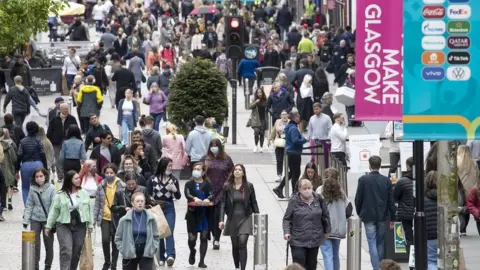Scottish shop sales return to pre-pandemic levels
 PA Media
PA MediaShop sales in Scotland have returned to pre-pandemic levels for the first time since the health crisis began, according to new data.
Figures released by the Scottish Retail Consortium (SRC) showed total sales last month were 0.6% up on March 2019.
However, it attributed the improvement in part to rising prices, rather than increased sales volumes.
The industry body also warned that "economic storm clouds" such as rising costs and inflation remained a concern.
March's figures showed overall food sales increased by 6%, compared with the same period three years ago, while the non-food category was down by 3.9%.
SRC said food was driven by higher inflation and customers focusing more on eating at home than at eateries. It also benefited from the first Mother's Day in three years when Scots could visit family.
Fashion and beauty lines also performed better, as did furniture and electrical shops as supply challenges eased.
Rising prices
SRC head of policy Ewan MacDonald-Russell said March sales had "sparkled" compared with recent months, following the removal of nearly all Scottish Covid restrictions.
However, he told BBC Radio Scotland's Good Morning Scotland programme: "There's an awful lot of concerning stuff underneath the top lines. We've got a lot of inflation and still huge supply-chain challenges.
"The other thing we see is quite a big gap between food and non-food. That tends to imply people are spending more of their money on essentials, and a lot less on the kind of more frivolous things, and that's quite concerning.
"It's the bits of retail which have struggled so much over the last two years, which are at the more discretionary end - people buying nice clothes, people buying more frivolous things - these are exactly the things people cut back on when their basics go."


The return to pre-pandemic level of sales isn't much of an achievement if it is caused by price inflation. And after a severe battering in recent years, the cost-of-living crisis confronts retailers with new challenges.
This was the sector that wasn't just hit hard by Covid, but was already struggling due to structural change. So it was never likely to be a full recovery, but an acceleration of existing trends and new business shapes emerging.
The growth in grocery home delivery was slowing up until pandemic hit. Lockdown then forced a rapid shift to consumer habits that have continued to be dynamic between shop visits, use of convenience stores and big weekly shops.
The decline in conventional shopping, particularly on high streets, raises questions much bigger than sales figures, prompting retailers to set out how they can make shopping a more appealing prospect.

KPMG's UK head of retail, Paul Martin, said that while the latest figures were promising, it was too early to call them a return to normality.
He added: "As households feel the pressure, retailers are facing their own battle with rising costs and inflation, and are walking a tightrope between absorbing rising costs themselves or passing these on to consumers.
"It remains to be seen whether or not consumers will reduce physical and virtual spending to offset rising household bills and reduced household incomes."


